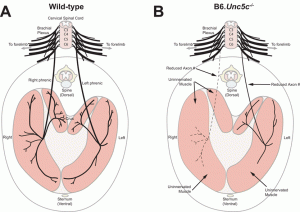Unilateral Diaphragmatic Paralysis
A 56-year-old white man was admitted to our hospital after having been found unconscious in his automobile which had been left in operation in a closed garage. He had a previous history- of depression with a past medical history of hypertension, non-insulin-dependent diabetes mellitus and a cerebrovascular accident. Initial physical examination revealed that he was afebrile, had spontaneous but labored respirations and was unresponsive to painful stimul. His initial arterial blood gas values on 5 L of oxygen by nasal cannula revealed mild hypoxemia but no acidosis. His carboxyhemoglobin level, measured approximately 2 h after being found, was 10.2 g percent (Instrumentation Laboratories СО-oximeter). The white blood cell count was 15,200/cu mm with a normal differential cell count. Serum glucose level was 283 mg percent and serum electrolyte values were normal. Chest x-ray film showed an elevated right hemidiaphragm while a comparison film taken 22 months previously was normal. 
He was treated with high flow oxygen. Within 24 h his carboxyhemoglobin level had fallen to 1.3 g percent and his neurologic examination was normal. Fluoroscopy revealed paradoxic motion of the right hemidiaphragm and an abdominal ultrasound did not reveal any mass in the right upper quadrant of his abdomen. On day 4 he was considered medically stable and was transferred to pons and the base of the medulla. Behavioral respiratory control resides in prepontine structures. Outflow pathways to the phrenic nerve are located in the upper (C2-C5) cervical spinal cord.
Respiratory failure in patients with MS is rare, but when reported has been associated with significant bulbar or limb paralysis. A recent study suggests that MS patients who remain ambulatory are unlikely to have serious compromise of respiratory function. In 1952, Guthrie et al described acute respiratory failure in four MS patients. Each developed acute quadriparesis with decreased thoracic excursions following the onset of dyspnea. Autopsy results were available in one patient, which revealed extensive active demyelina-tion of the posterior and lateral columns of lower cervical segments as well as the entire cross section of the upper thoracic cord.
Treatment Erectile Dysfunction in Canada: www.acanadianhealthcaremall.com

